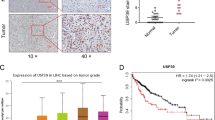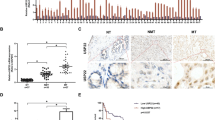Abstract
The ubiquitin-like modifier (UBL) family has recently generated much interest in the scientific community, as it is implicated to play important regulatory roles via novel protein–protein modification. FAT10 (diubiquitin) belongs to this family of proteins, comprising two ubiquitin-like moieties fused in tandem, and has been implicated to be involved in the maintenance of spindle integrity during mitosis. As FAT10 may play a role in the regulation of genomic stability, we examined if there is an association between FAT10 expression and hepatocellular carcinoma (HCC) or other cancers. Northern blot analyses revealed upregulation of FAT10 expression in the tumors of 90% of HCC patients. In situ hybridization as well as immunohistochemistry utilizing anti-FAT10 antibodies localized highest FAT10 expression in the nucleus of HCC hepatocytes rather than the surrounding immune and non-HCC cells. FAT10 expression was also found to be highly upregulated in other cancers of the gastrointestinal tract and female reproductive system. In conclusion, we demonstrated upregulation of FAT10 expression in various gastrointestinal and gynecological cancers. Its overexpression is unrelated to the general increase in protein synthesis or a general immune/inflammatory response to cancer. Rather, FAT10 may modulate tumorigenesis through its reported interaction with the MAD2 spindle-assembly checkpoint protein.
This is a preview of subscription content, access via your institution
Access options
Subscribe to this journal
Receive 50 print issues and online access
$259.00 per year
only $5.18 per issue
Buy this article
- Purchase on Springer Link
- Instant access to full article PDF
Prices may be subject to local taxes which are calculated during checkout







Similar content being viewed by others
References
Bates EE, Ravel O, Dieu MC, Ho S, Guret C, Bridon JM, Ait-Yahia S, Briere F, Caux C, Banchereau J and Lebecque S . (1997). Eur. J. Immunol., 27, 2471–2477.
Biggins S, Bhalla N, Chang A, Smith DL and Murray, AW . (2001). Genetics, 159, 453–470.
Biggins S, Ivanovska I and Rose MD . (1996). J. Cell Biol., 133, 1331–1346.
Boddy MN, Howe K, Etkin LD, Solomon E and Freemont PS . (1996). Oncogene, 13, 971–982.
Braissant O, and, Wahli W . (1998). Biochemica, 1, 10–16.
Fan W, Cai W, Parimoo S, Schwarz DC, Lennon GG and Weissman SM . (1996). Immunogenetics, 44, 97–103.
Gemma A, Hosoya Y, Seike M, Uematsu K, Kurimoto F, Hibino S, Yoshimura A, Shibuya M, Kudoh S and Emi M . (2001). Lung Cancer, 32, 289–295.
He TC, Zhou S, da Costa LT, Yu J, Kinzler KW and Vogels-tein B . (1998). Proc. Natl. Acad. Sci. USA, 95, 2509–2514.
Hochstrasser M . (1996a). Cell, 84, 813–815.
Hochstrasser M . (1996b). Annu. Rev. Genet., 30, 405–439.
Hooi SC, Koenig JI, Abraczinskas DR and Kaplan LM . (1997). Brain Res. Mol. Brain Res., 51, 15–22.
Iwai K, Yamanaka K, Kamura T, Minato N, Conaway RC, Conaway JW, Klausner RD and Pause A . (1999). Proc. Natl. Acad. Sci. USA, 96, 12436–12441.
Iwanaga Y, Kasai T, Kibler K and Jeang KT . (2002). J. Biol. Chem., 277, 31005–31013.
Jentsch S and Pyrowolakis G . (2000). Trends Cell Biol., 10, 335–342.
Jesenberger V and Jentsch S . (2002). Nat. Rev. Mol. Cell Biol., 3, 112–121.
Komminoth P, Merk FB, Leav I, Wolfe HJ and Roth J . (1992). Histochemistry, 98, 217–228.
Lee CG, Ramachandra M, Jeang KT, Martin MA, Pastan I and Gottesman, MM . (2000). FASEB J., 14, 516–522.
Liu YC, Pan J, Zhang C, Fan W, Collinge M, Bender JR and, Weissman SM . (1999). Proc. Natl. Acad. Sci. USA, 96, 4313–4318.
Michel LS, Liberal V, Chatterjee A, Kirchwegger R, Pasche B, Gerald W, Dobles M, Sorger PK, Murty VV and Benezra, R . (2001). Nature, 409, 355–359.
Muller S, Matunis MJ and Dejean A . (1998). EMBO J., 17, 61–70.
Okura T, Gong L, Kamitani T, Wada T, Okura I, Wei CF, Chang HM and Yeh ET . (1996). J. Immunol., 157, 4277–4281.
Pickart CM . (1997). FASEB J., 11, 1055–1066.
Raasi S, Schmidtke G, de Giuli R and Groettrup M . (1999). Eur. J. Immunol., 29, 4030–4036.
Raasi S, Schmidtke G and Groettrup M . (2001). J. Biol. Chem., 276, 35334–35343.
Ruffner H, Joazeiro CA, Hemmati D, Hunter T and Verma IM . (2001). Proc. Natl. Acad. Sci. USA, 98, 5134–5139.
Sampson DA, Wang M, Matunis MJ . (2001). J. Biol. Chem., 276, 21664–21669.
Shah JV and Cleveland DW . (2000). Cell, 103, 997–1000.
Tateishi K, Omata M, Tanaka K and Chiba T . (2001). J. Cell Biol., 155, 571–579.
Wang X, Jin DY, Wong YC, Cheung AL, Chun AC, Lo AK, Liu Y and Tsao SW . (2000). Carcinogenesis, 21, 2293–2297.
Acknowledgements
We are greatly indebted to Professor Chi V Dang, Department of Medicine, Johns Hopkins University School of Medicine, USA, for his invaluable guidance and advice throughout this project. We thank Dr Samuel S Chong, Department of Pediatrics and Obstetrics and Gynecology, NUS for the provision of the pCMVDsRed plasmid and critical review of the manuscript. We acknowledge the Thailand Research Fund Grant Number RSA04/2540 (to IN) and the National Cancer Center Tissue Repository in Singapore for providing HCC tissues used in this study. This work was funded by grants from the Agency for Science, Technology and Research of Singapore, through Johns Hopkins Singapore (to CGLL and LAL) as well as SingHealth Cluster Research Fund through the National Cancer Center to CGLL (BF015/2002).
Author information
Authors and Affiliations
Corresponding author
Rights and permissions
About this article
Cite this article
Lee, C., Ren, J., Cheong, I. et al. Expression of the FAT10 gene is highly upregulated in hepatocellular carcinoma and other gastrointestinal and gynecological cancers. Oncogene 22, 2592–2603 (2003). https://doi.org/10.1038/sj.onc.1206337
Published:
Issue Date:
DOI: https://doi.org/10.1038/sj.onc.1206337
Keywords
This article is cited by
-
FAT10 promotes chemotherapeutic resistance in pancreatic cancer by inducing epithelial-mesenchymal transition via stabilization of FOXM1 expression
Cell Death & Disease (2022)
-
A robust gene expression signature for NASH in liver expression data
Scientific Reports (2022)
-
The ubiquitin-like modifier FAT10 interferes with SUMO activation
Nature Communications (2019)
-
The structure of the ubiquitin-like modifier FAT10 reveals an alternative targeting mechanism for proteasomal degradation
Nature Communications (2018)
-
The expression profile of the ubiquitin-like modifier FAT10 in immune cells suggests cell type-specific functions
Immunogenetics (2018)



